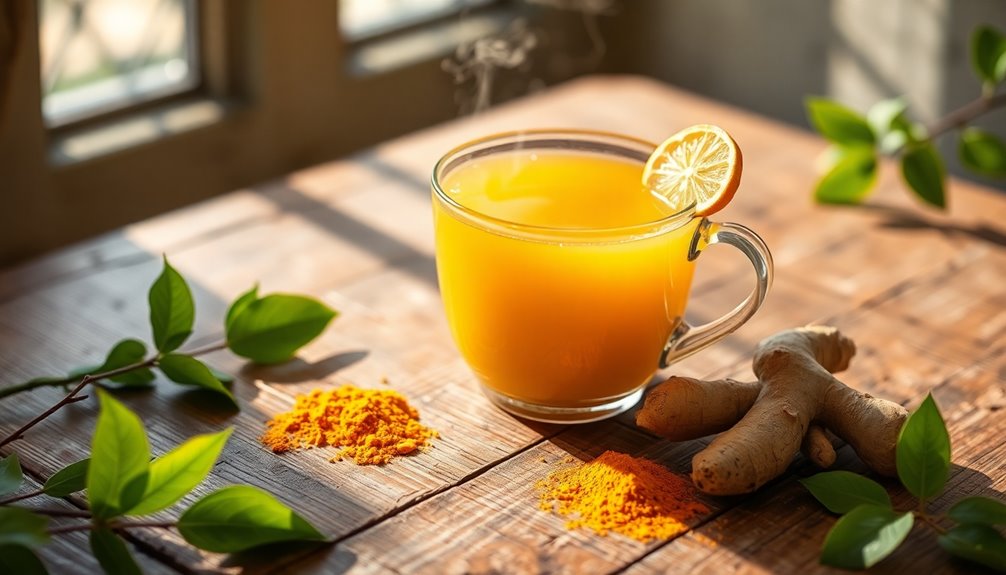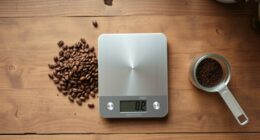Coffee's acidity gives it that bright, tangy flavor you love, but it can also lead to heartburn for some. The acidity level depends on various factors like the type of beans and how they're roasted. Dark roasts usually have lower acidity, making them easier on your stomach. If you're sensitive, consider options like cold brew, which is up to 70% less acidic than hot coffee. Experimenting with grind size and brewing methods can also make a difference. There's plenty more to explore, so keep going to uncover more about your favorite beverage!
Key Takeaways
- Coffee acidity contributes to flavor complexity, with organic acids like citric and malic enhancing brightness in high-altitude Arabica beans.
- Dark roasts have lower acidity, making them a better choice for individuals prone to heartburn or digestive discomfort.
- Cold brew coffee is significantly less acidic than traditional hot coffee, offering a gentler option for sensitive stomachs.
- Grind size impacts acidity; coarser grinds reduce acidity while finer grinds increase it, affecting overall flavor and drinkability.
- Pairing coffee with milk can help neutralize acidity, providing a smoother drinking experience for those sensitive to heartburn.
Understanding Coffee Acidity

When you sip your coffee, you might notice a bright, tangy flavor that makes each cup unique. This is what we refer to as coffee acidity, a vital aspect of high-quality coffee.
The pH of your brew typically ranges from 4.5 to 6.0, with lower pH values indicating higher acidity. If you enjoy Arabica beans, you'll often find that those grown at higher altitudes provide more vibrant flavor profiles.
Organic acids like citric and malic contribute to this complexity. For coffee drinkers sensitive to acidity, choosing low acid coffee can help reduce acidity without sacrificing taste.
Understanding these nuances in the brewing process helps you select the perfect cup, tailored to your palate.
Impact of Roast and Grind

The roast level and grind size of your coffee play essential roles in determining its acidity.
Dark roast coffee tends to have low acidity because the longer roasting time breaks down more acids. In contrast, light roasts, especially those made from Arabica coffee, maintain higher acidity levels, creating a brighter flavor profile.
Your grind size also matters; a coarser grind slows extraction during brewing, leading to less acidity in your cup.
If you're sensitive to heartburn, consider combining dark roast coffee with naturally low-acid bean types, like Brazilian or Sumatran varieties. These choices can improve drinkability while still allowing you to enjoy the unique flavor profiles that different coffee beans grow in various regions offer.
Brewing Methods and Acidity

While each brewing method brings out different flavors in your coffee, it also greatly affects its acidity. For instance, cold brew can have around 70% less acidity compared to hot coffee due to its longer steeping time.
Here are three key factors influencing acidity:
- Brewing Temperature: Higher temperatures can increase acidity, affecting the pH level of your coffee.
- Grind Size: A coarser grind typically results in less acidity, while finer grinds enhance acidity during extraction.
- Water Quality: The pH and chemistry of your water can dramatically impact the flavor qualities and acidity of your brew.
Understanding these elements can help you tailor your brewing methods for a more enjoyable coffee experience!
Health Effects of Acidity

When you enjoy a cup of coffee, you mightn't realize how its acidity can impact your digestion.
For some, the increased stomach acid production can lead to discomfort, especially if you're sensitive to acidity.
It's important to reflect on how your body reacts and explore options that might ease those effects.
Digestive Discomfort Factors
For many coffee lovers, acidity can be a double-edged sword. While it enhances your coffee experience, it can also lead to digestive discomfort. Here are three factors to evaluate:
- pH Scale: Coffee's average pH ranges from 4.85 to 5.10; lower pH means higher acidity, which may trigger heartburn.
- Organic Acids: Compounds like chlorogenic, citric, and malic acids add brightness but can irritate your digestive tract if you're sensitive.
- Brew Type: Dark roast coffees typically have lower acidity, making them a safer option for those prone to discomfort.
Cold brew, being over 60% less acidic, offers a smoother alternative, allowing you to enjoy coffee without as much risk of heartburn or other digestive issues. Additionally, glycolic acid has been shown to help improve overall skin health, which can be beneficial if you're experiencing skin irritation as a result of digestive discomfort.
Stomach Acid Stimulation
Coffee's acidity can markedly impact your digestive health, particularly by stimulating stomach acid production.
While this increased acid can aid digestion, it can also exacerbate heartburn and discomfort, especially if you're sensitive to high-acid beverages.
The average pH of brewed coffee ranges from 4.5 to 6.0, meaning lower pH values indicate higher acidity that some may find hard to tolerate.
Organic acids like chlorogenic and citric acids contribute to coffee's flavor complexity but can trigger digestive issues for certain individuals.
If you often experience stomach discomfort, opting for low-acid coffee might be your best choice.
It'll offer a smoother experience without the harsh effects of high acidity, helping you enjoy your coffee without the worry of digestive repercussions. Additionally, maintaining adequate hydration can further support your digestive health and mitigate potential discomfort.
Low-Acid Coffee Options

If you're sensitive to acidity, exploring low-acid coffee options can make a significant difference in your enjoyment of this beloved beverage.
Many coffee lovers find solace in these varieties, which often have lower acidity. Here are three popular choices:
- Cold Brew Coffee: This method yields a brew that's over 60% less acidic than traditional hot coffee, making it ideal for those with acid reflux.
- Darker Roasts: Beans like medium-dark Peruvian Pangoa or dark roast Mexican Yachil have a smoother flavor profile and lower acidity compared to light roasts.
- Adding Milk: This simple technique can help neutralize acids, providing a gentler drinking experience with your favorite brew made in your coffee maker. Additionally, improving your overall respiratory health may enhance your coffee enjoyment by reducing sensitivity to acidity.
Tips for Enjoying Coffee

Finding ways to enjoy coffee without discomfort can enhance your overall experience. Start by trying cold brew coffee; it's over 60% less acidic than traditional brewing methods, giving you a smoother taste.
When you brew your coffee, opt for dark roast Sumatran or medium-dark roast Peruvian Pangoa, which are naturally low in acidity. Experiment with different types of beans, as high-altitude Arabica beans usually have higher acidity, while Robusta and dark roasts are less acidic.
Additionally, using a coarser grind can help reduce acidity, making it easier on your stomach. Don't forget to incorporate milk or cream, as dairy can neutralize acidity and alleviate heartburn symptoms.
For an additional health benefit, consider enjoying your coffee alongside teas that increase serotonin, as they can promote relaxation and enhance your mood during your coffee journey!
Frequently Asked Questions
How Do I Stop Coffee From Giving Me Acid Reflux?
To stop coffee from giving you acid reflux, try opting for low-acid varieties like Robusta or beans grown at lower elevations. In addition, consider brewing methods that reduce acidity, such as cold brewing or using certain filters that can minimize acid content. Monitoring your coffee consumption and acid reflux can help you identify specific triggers, allowing for better management of your symptoms. Remember that pairing your coffee with food can also help neutralize some of the acidity, making your coffee experience more enjoyable without the discomfort.
Switch to cold brewing, which can greatly cut acidity levels. Drink your coffee with food to help buffer its effects, and consider adding milk or cream to neutralize stomach acid.
You might also experiment with darker roasts, as they generally have lower acidity and could ease your digestive discomfort.
What Does It Mean When Coffee Tastes Acidic?
When coffee tastes acidic, it means you're experiencing bright, tangy flavors that can remind you of fruits. This acidity comes from organic compounds in the beans, and it often varies by the type of coffee you choose.
If you prefer lighter roasts, you'll likely notice more acidity, while darker roasts offer a bolder flavor with less tang. Your brewing method can also affect this perception, especially if you opt for cold brew.
How to Get the Acidic Taste Out of Coffee?
To get the acidic taste out of your coffee, start by choosing low-acid coffee beans from regions like Brazil or Sumatra.
You can also opt for a darker roast, which tends to have less acidity.
Brewing using the cold brew method greatly lowers acidity levels.
Adding milk or cream can help neutralize sharp flavors.
Finally, consider incorporating a pinch of salt or crushed eggshells to balance the taste and enhance your coffee experience.
What Are the Symptoms of Coffee Acidity?
When you drink coffee, you might notice some symptoms of acidity. You could experience heartburn or a burning sensation in your chest and throat.
If you're sensitive to acidic foods, you may feel gastrointestinal discomfort or acid reflux afterward. Light roasts often have higher acidity, increasing the chance of these issues.
If you find coffee bothersome, switching to darker roasts or cold brew might help reduce these unpleasant symptoms.
Conclusion
In understanding coffee acidity, you can enhance your enjoyment and avoid discomfort. By recognizing how roast and grind affect flavor, choosing the right brewing method, and exploring low-acid options, you're empowered to savor every sip. Remember, it's all about balance: enjoy the richness, appreciate the depth, and embrace the warmth of your coffee. So, whether you're brewing a bold cup or a smooth blend, you can find your perfect brew without the heartburn.










